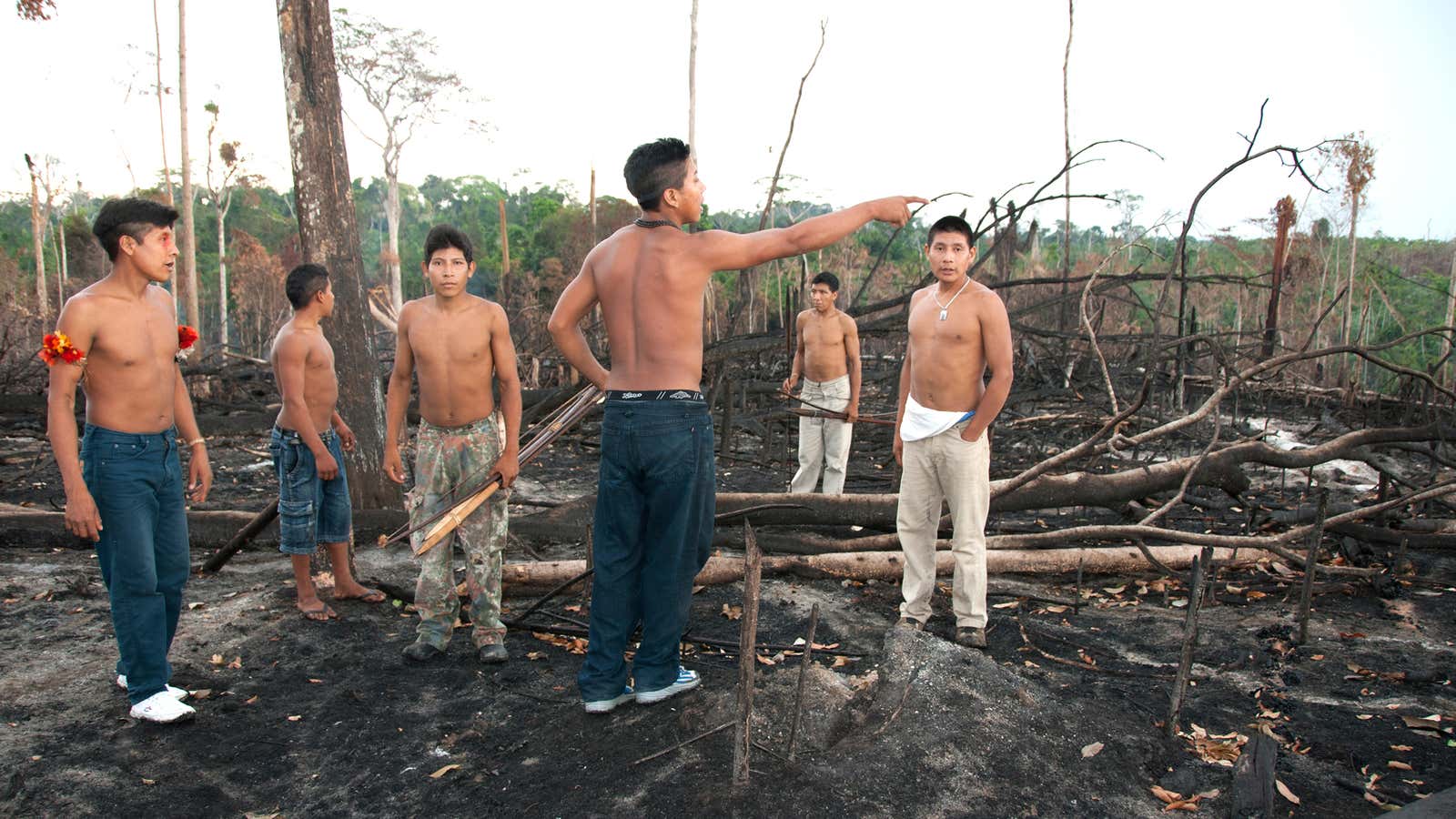Deep in the eastern Amazon rainforest, loggers armed with guns are lighting fires inside the territory of an uncontacted tribe with roughly 100 members left.
This has happened during every dry season in recent years, fragmenting the tribe’s reserved land piece by piece, according to Survival International, an organization dedicated to protecting forest people. Loggers enter the Awá’s territory and light fires to burn the underbrush, so they can more easily access and fell the large, old-growth hardwood trees.
Across the Amazon, fires set mostly by cattle ranchers, miners, and loggers are burning swaths of rainforest where indigenous people live. The Amazon is home to some 306,000 indigenous people, who have legal rights to 422 reserves, or nearly a quarter of the land area of the Amazon basin. In many cases, tribes already struggle to defend their land from invasion by illegal loggers and miners. But in light of the current Brazilian government’s open disdain for the reserve system, indigenous people are even more vulnerable.
Perhaps most vulnerable are the estimated 100 uncontacted groups living in the Brazilian Amazon, of which the Awá are one.
The news that the loggers have arrived this year was relayed on Wednesday (Aug. 28) to Survival International by way of members of the nearby Guajajara tribe, which has formed firefighting patrols to keep watch for the illegal loggers who threaten the Awá’s remaining scraps of intact rainforest.
Some 350 members of the Awá live in settlements in the same region, and maintain contact with the outside world. But roughly 100 remain uncontacted, living entirely within the forest, and are considered by Survival International to be the most threatened tribe in the world. They live on five fragmented sections of rainforest, each of them technically protected indigenous reserves. But illegal logging continues, and more of the Amazon is burning this dry season than has burned in years.
The news of the latest fires comes from the Arariboia Indigenous territory, one of the five places the Awá still live. The loggers who set the fires are heavily armed, and are preventing the Guajajara firefighters from battling the blazes, according to Jonathan Mazower, the communication director of Survival International.
Armed loggers have reportedly massacred members of the uncontacted Awá tribe in the past. In one documented case from 2014, two elderly sisters were forced to emerge from the forest into a contacted Awá village, after contracting influenza and tuberculosis to which they had no immunity. After being treated, they chose to return to the forest to continue living as uncontacted tribe members, erasing their tracks behind them. In 2016, one of the sisters was found shot by a logger, according to Survival International.
The area that includes the Awá’s territory is targeted by loggers for its “ipe” wood, also called “Brazilian walnut,” a popular hardwood used for flooring, decks, and high-end construction. It is extremely difficult to track whether hardwood purchased at a lumberyard came from illegal logging in the Amazon, or from the Awá’s territory. “The wood is being processed by illegal sawmills. There’s not any reliable documentation,” says Mazower.
Uncontacted tribes typically prefer to live apart from other societies, and it is common for them to take measures to remain so. What happens after contact can be disastrous: It is typical for 50% of the tribe, or more, not to survive the first few years of contact, according to Survival International.
Research has shown that indigenous management practices are the best approach to maintaining the health of tropical rainforests globally. Where rainforests are managed by indigenous tribes, they typically thrive.
Indigenous reserves are often the only bulwark against deforestation in the Brazilian Amazon, unless the protected status remains unenforced. Under Bolsonaro, rollbacks of environmental protections and a lack of enforcement of existing regulations are pushing deforestation rates in the rainforest to levels not seen in over a decade.
“The prevention of this in the future is not really a question of money. To properly protect the rainforest and the indigenous territories in particular is just a question of the political will of the government,” says Mazower. “They’ve got the resources. It’s just a matter of whether they choose to put it towards that or not.”
Bolsonaro has likened indigenous reserves in the Amazon to “chickenpox” on the land, and promised prior to his election that “there won’t be a square centimeter demarcated as an indigenous reserve” under his leadership. In 1998, in a speech on the floor of congress, he praised how well Americans had slaughtered their indigenous population. “The Brazilian was very incompetent,” he said. “Competent, yes, was the American cavalry that decimated its Indians in the past and nowadays does not have this problem in their country.”
It is hardest to assess the damage of the Bolsonaro presidency on uncontacted tribes, says Christian Poirier, the program director for Amazon Watch, a nonprofit organization that advocates against industrial activity in indigenous territory. That makes them more vulnerable to invasion by loggers and ranchers.
“You can’t get reliable information about how they’re treated in the hands of these brutal actors,” Poirier says, except in the rare case that they do make contact with the outside world. “Indigenous people in voluntary isolation have been penned in. Their forests have been shrinking around them,” he says. “The Bolsonaro regime is doing the bidding of Brazil’s agribusiness sector.”
